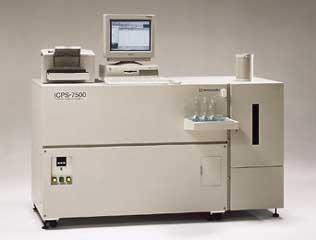|
Instrument Database:
Shimadzu Corporation - ICPS-7500 Sequential Plasma Emission Spectrometer
| |
|

|
| |
|
| |
|
| Year of introduction |
|
| Status |
historical ( out of sale ) |
| Company |
Shimadzu Corporation
|
| Categories |
Spectrometer ( Atom. ): AES: ICP-AES
|
Emission spectrometers using an inductively coupled plasma (ICP) as the excitation source have various advantages over those using a conventional excitation source, and hence have come to be utilized more and more extensively.
The important features of the ICP are: - Detection limit of ppb quantity level.
- No matrix effect.
- Wide measurable concentration range.
- High stability and reproducibility.
With these and many other advantages, ICP spectrometers are widely used; their application fields include elemental analysis for quality control, ultratrace element determination such as for environmental water quality monitoring, and major element determination such as for composition determination.
In order for an ICP spectrometer to get the maximum use of the above features, it is required that: - The spectrometer provides high resolution over a wide wavelength range.
- Acidic/aqueous solution samples and organic solvent solution samples can be analyzed without addition or replacement of the units of the instrument.
- The RF generator, spectrometer, and gas flow control unit ensure high stability.
- Running cost is low.
- Ease and simplicity of operation are ensured through automation, and the data system provides a wide variety of data processing functions.
The Shimadzu ICOS-7500 is the latest, sequential, inductively coupled plasma emission spectrometer designed to satisfy all of these requirements.
Large database and many software programs are readily available.
|
| Specifications |
|
|
1. Spectrometer Unit
Optical system:
Double grating Czerny-Turner mounting
Focal length:
1000 mm
Number of grooves:
3600 grooves/mm for 160 - 458 nm
1800 grooves/mm for 458 - 850 nm
Reciprocal dispersion:
0.22 nm/mm (3600 grooves/mm grating)
0.44 nm/mm (1800 grooves/mm grating)
Photomultiplier:
R 2989 for short wavelength range
R 2987 for long wavelength range
Slit width:
Entrance slit: 20 mm
Exit slit: 30 mm
Wavelength scanning:
Sine-bar method, Driven by a computer-controlled pulse motor. 0.0002 nm minimum drive steps, 50 nm/sec. maximum driving speed (3600 grooves/mm grating)
Evacuation unit:
Proportional control (38°C ± 0.1°C) Rotary pump, 160l/min, displacement. Check valve attached.
2. ICP Light Source
Torch section:
Cyclone spray chamber Quartz plasma torch
Coaxial type nebulizer
Observation position switching:
2 steps up/down
(when observing from the horizontal direction)
Radio frequency:
Match box
Gas controller:
3 flow routes for plasma
Flow rate setting range (computer control)
Coolant gas:
2 - 20l/min
Plasma gas:
0.2 - 1.4l/min
Carrier gas:
0.1 - 1.5l/min
Purge gas:
3.5l/min
Axial direction observation attachment:
Observation direction can be changed (horizontal and axial directions).
|
Related links:
|